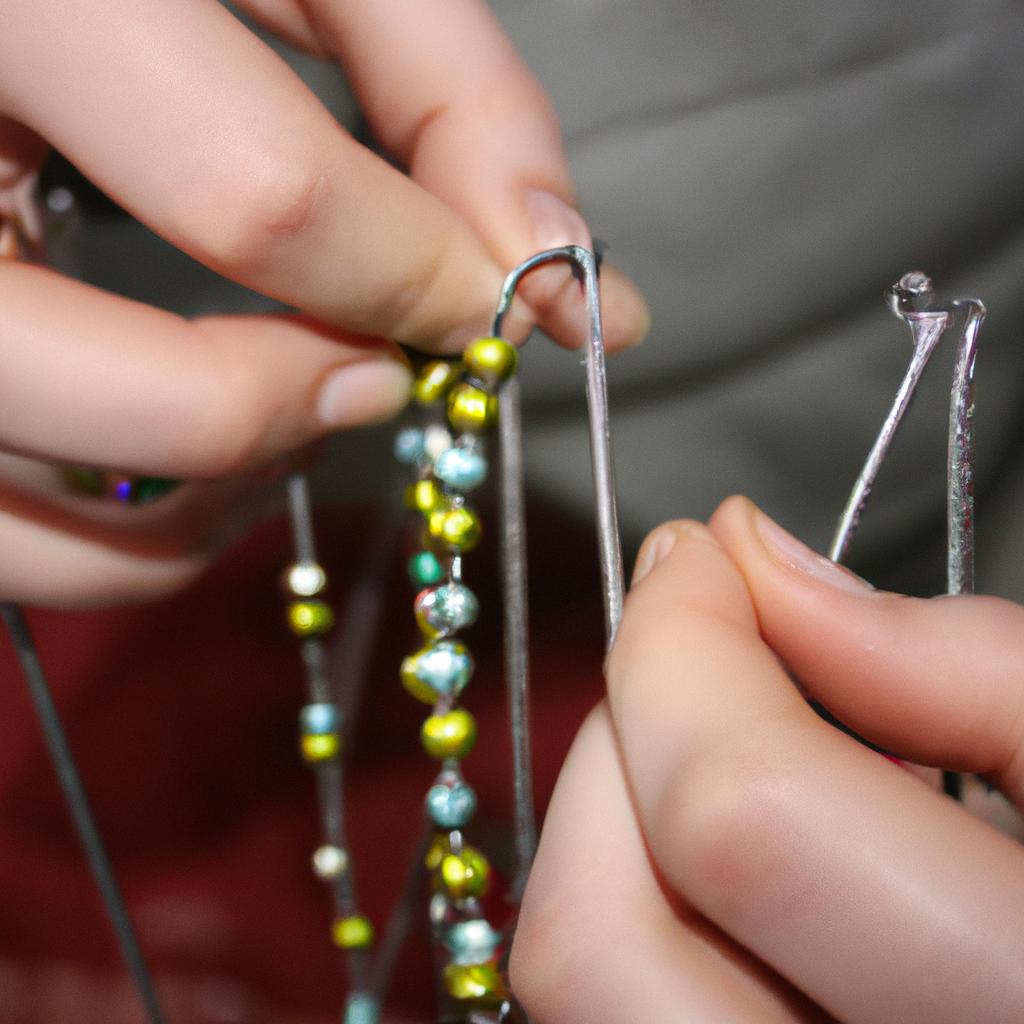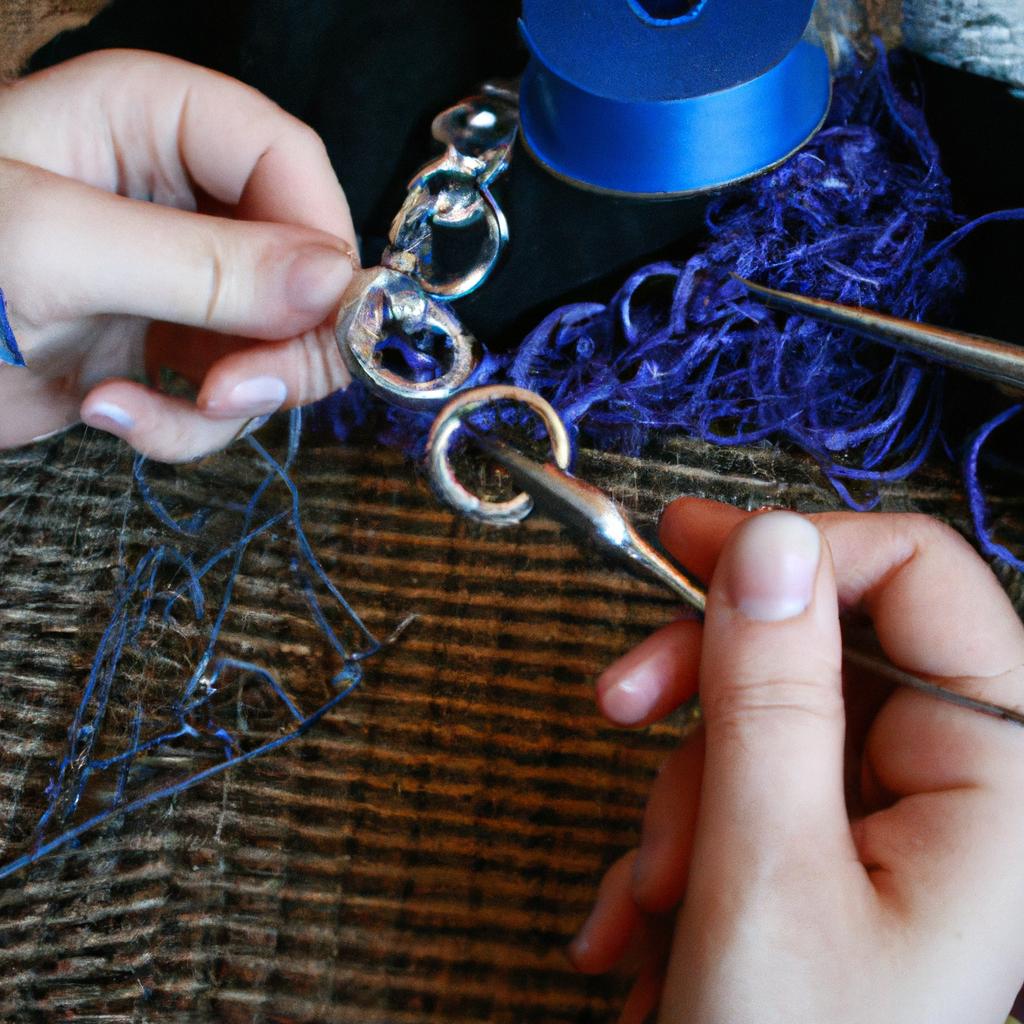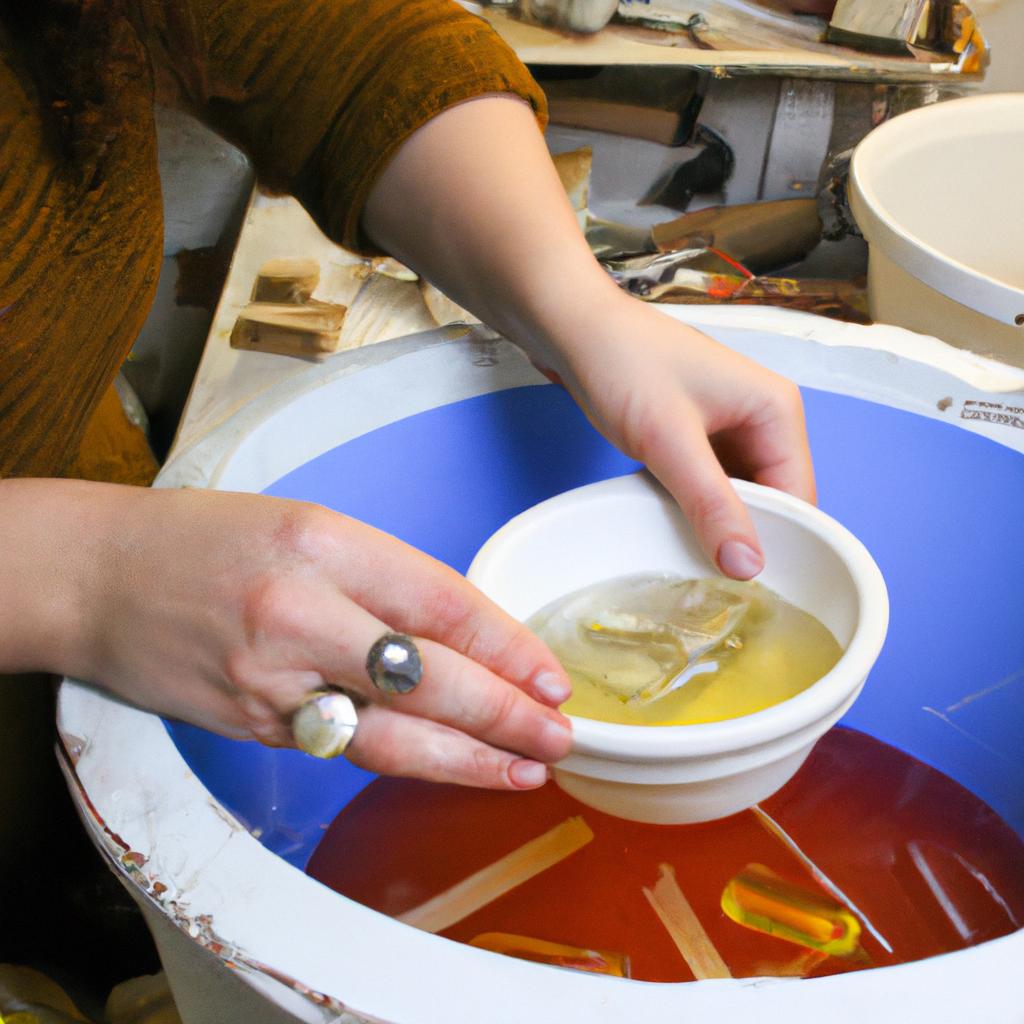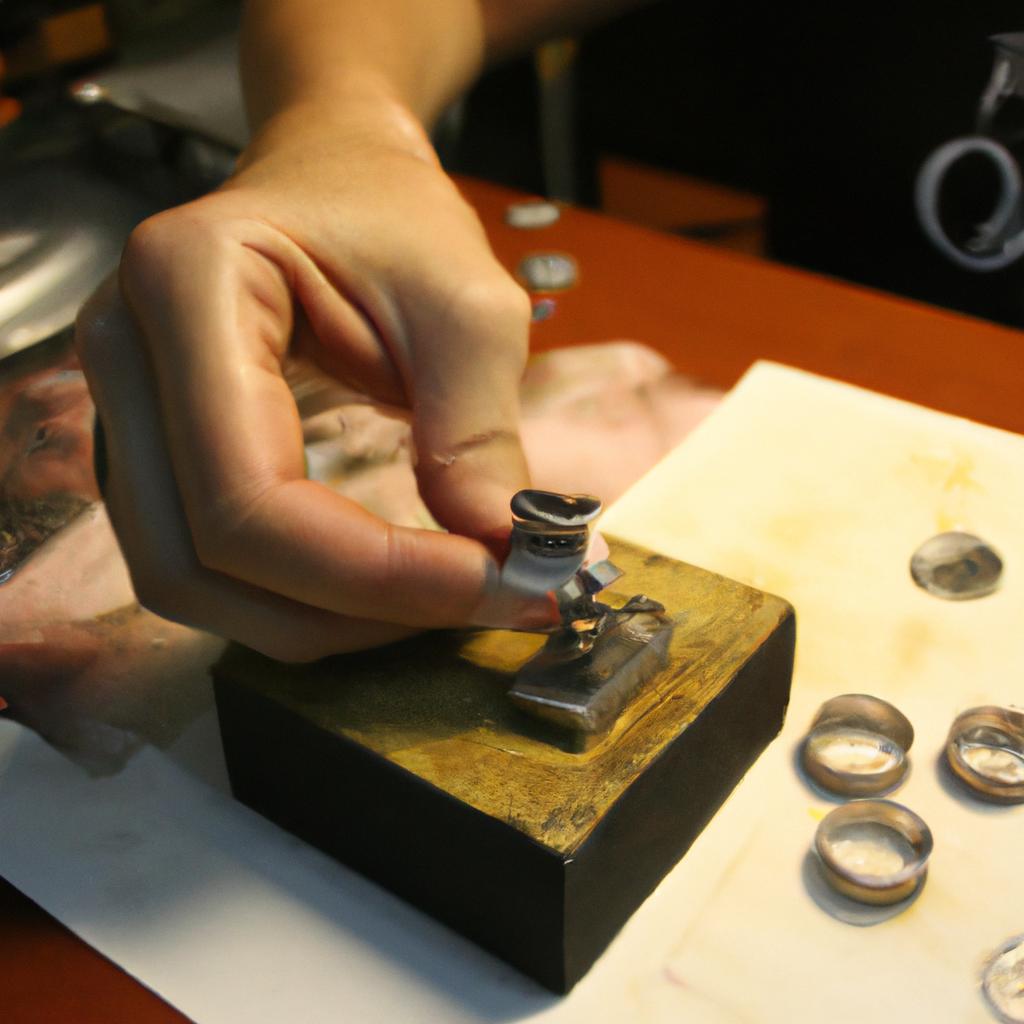Polymer clay has emerged as a versatile and popular material in the field of jewelry making. Its unique properties, such as flexibility, durability, and vibrant color options, make it an ideal choice for creating intricate and stunning pieces. For instance, imagine a delicate necklace adorned with intricately crafted polymer clay beads that mimic the appearance of gemstones. In this article, we will explore the various aspects of polymer clay in jewelry making, providing an informative guide to its characteristics, techniques, and potential applications.
To fully appreciate the use of polymer clay in jewelry making, it is essential to understand its distinctive features. Unlike traditional clays, polymer clay is composed primarily of polyvinyl chloride (PVC) particles suspended in a plasticizer medium. These components allow for easy manipulation and molding while retaining shape when cured at low temperatures. Additionally, polymer clay offers an extensive range of colors due to the inclusion of pigments during manufacturing or by mixing different shades together. This versatility allows artisans to create jewelry pieces that are both visually captivating and uniquely personal.
The process of working with polymer clay involves several techniques that contribute to its creative appeal. Techniques such as caning, millefiori, and sculpting enable artists to produce intricate patterns and textures on their jewelry pieces. Caning involves creating intricate designs by layering and compressing thin slices of clay, resulting in patterns reminiscent of glass or ceramic canework. Millefiori, a technique borrowed from glassmaking, involves creating a patterned cane that is then sliced and applied to the jewelry piece, producing a kaleidoscopic effect. Sculpting allows artists to shape the clay into three-dimensional forms, such as flowers, animals, or abstract shapes, adding depth and dimension to their designs.
Another notable aspect of polymer clay is its ability to be combined with other materials to create unique mixed media pieces. Artists often incorporate metal findings, beads, gemstones, or even fabric into their polymer clay creations, further enhancing their visual appeal and expanding the range of possibilities for design.
In terms of applications, polymer clay offers endless opportunities for creativity in jewelry making. It can be used to make earrings, bracelets, necklaces, pendants, brooches – essentially any type of jewelry piece imaginable. The lightweight nature of polymer clay makes it comfortable to wear while still maintaining durability. Its flexibility also allows for interesting shapes and designs that may not be achievable with traditional metals or stones.
When working with polymer clay for jewelry making purposes, there are a few important considerations to keep in mind. Firstly, proper curing is essential for achieving optimal strength and durability in the finished piece. Polymer clay typically needs to be baked at specific temperatures according to the manufacturer’s instructions. Over-baking can result in discoloration or brittleness while under-baking may cause the piece to break easily.
Additionally, it is crucial to handle polymer clay properly to avoid contamination or unwanted fingerprints on the surface. Using tools specifically designed for working with polymer clay can help achieve clean lines and smooth finishes.
In conclusion, polymer clay offers a wealth of creative possibilities in jewelry making due to its unique properties and versatility. From intricate caning techniques to sculpting three-dimensional forms, artists can create stunning and personalized pieces that rival the beauty of traditional gemstones. With careful handling and proper curing, polymer clay jewelry can be enjoyed for years to come. So, why not explore the world of polymer clay and unleash your artistic potential in jewelry making?
Choosing the Right Polymer Clay for Jewelry
Polymer clay is a versatile material that has gained popularity in jewelry making due to its flexibility, durability, and vibrant colors. When selecting polymer clay for your jewelry projects, it is essential to consider factors such as brand reputation, color range, texture, and compatibility with other materials.
To illustrate this point, let’s imagine you are creating a pair of earrings featuring intricate floral designs. Using a high-quality polymer clay with excellent workability will ensure that you can achieve fine details without compromising the overall strength of the piece.
When choosing the right polymer clay for your jewelry creations, there are several key considerations to keep in mind:
- Brand Reputation: Opting for well-established brands known for their quality ensures consistency in color accuracy and performance.
- Color Range: Look for brands or lines offering a wide variety of colors to suit your artistic vision and allow for creative combinations.
- Texture: Different brands offer varying degrees of firmness or softness, allowing artists to choose based on their preferred handling qualities.
- Compatibility: Consider whether the clay is compatible with other materials you may want to incorporate into your design, such as metal findings or gemstones.
By keeping these factors in mind during the selection process, you can enhance both the aesthetic appeal and longevity of your polymer clay jewelry pieces.
| Brand Reputation | Color Range | Texture | Compatibility |
|---|---|---|---|
| Premium Brands | Vast Selection | Versatile | Compatible |
| Established Brands | Diverse | Workable | Partially Compatible |
| Lesser-Known Brands | Limited | Stiff or Soft | Incompatible |
In summary, when choosing polymer clay for jewelry-making purposes, considering aspects like brand reputation, color range, texture variations, and compatibility will help ensure optimal results. Now that we have covered selecting suitable clay, let’s explore the essential tools and materials required for polymer clay jewelry-making.
Essential Tools and Materials for Polymer Clay Jewelry
Polymer Clay in Jewelry Making: An Informative Guide
Choosing the Right Polymer Clay for Jewelry
Now that we have discussed the importance of choosing the right polymer clay for jewelry making, let’s delve deeper into the essential tools and materials needed to bring your creations to life. By having a clear understanding of these requirements, you can ensure that your jewelry pieces are not only visually appealing but also durable and long-lasting.
Essential Tools and Materials for Polymer Clay Jewelry
To craft stunning polymer clay jewelry, you will need a variety of tools and materials. Let’s take a look at some key essentials:
-
Work Surface:
- A non-porous surface such as glass or tile is ideal for working with polymer clay.
-
Blades:
- Sharp blades like precision knives or tissue blades are necessary for cutting through clay with precision.
-
Pasta Machine:
- A pasta machine helps condition clay evenly and allows you to achieve consistent thickness throughout your project.
-
Oven Thermometer:
- To ensure accurate curing temperatures, an oven thermometer is crucial. This ensures that your creations are properly cured without any risk of burning or discoloration.
By investing in these tools and materials, you can elevate your polymer clay jewelry-making experience while achieving professional-looking results.
Techniques for Creating Polymer Clay Jewelry
Building upon our discussion about selecting the right polymer clay and obtaining the necessary tools, let’s now explore various techniques used in creating exquisite polymer clay jewelry pieces. From shaping intricate designs to incorporating mixed media elements, there are endless possibilities when it comes to designing unique accessories that reflect your personal style.
Transitioning smoothly into Techniques for Creating Polymer Clay Jewelry, we will discover how different methods can be employed to transform raw clay into captivating wearable art forms.
Techniques for Creating Polymer Clay Jewelry
Polymer Clay in Jewelry Making: An Informative Guide
Essential Tools and Materials for Polymer Clay Jewelry have been discussed at length. Now, let’s delve into the Techniques for Creating Polymer Clay Jewelry. To exemplify the versatility of polymer clay, consider a hypothetical scenario where an artisan named Sarah wants to create a unique pendant necklace using polymer clay.
The first technique that Sarah can employ is millefiori, which involves creating intricate patterns by layering thin slices of different colored clay together. This process requires precision and patience but results in stunning designs reminiscent of glasswork. Another technique she could explore is called image transfer, where images from magazines or printed materials are transferred onto the surface of the clay through heat and pressure. This allows for endless possibilities in adding detailed imagery to jewelry pieces.
To evoke an emotional response in our audience, here are some key benefits of utilizing polymer clay in jewelry making:
- Versatility: Polymer clay can be molded into any shape imaginable, allowing artists like Sarah to unleash their creativity without limitations.
- Durability: Once baked, polymer clay becomes extremely durable and resistant to breakage or fading over time.
- Lightweight: Unlike traditional metal-based jewelry materials, polymer clay is lightweight, ensuring comfort when worn.
- Affordability: Compared to precious metals or gemstones, polymer clay is a cost-effective alternative that does not compromise on aesthetic appeal.
In addition to these techniques and benefits, there are various other methods used by artisans worldwide to create mesmerizing polymer clay jewelry. These include caning (creating complex designs by combining multiple layers), sculpting (molding three-dimensional shapes), and marbling (blending different colors together to achieve a swirled effect).
As we conclude this section on Techniques for Creating Polymer Clay Jewelry, it’s important to note that proper baking and finishing techniques play a crucial role in achieving professional-grade results. In the subsequent section about Baking and Finishing Polymer Clay Jewelry, we will explore the step-by-step process to ensure your creations are beautifully completed and ready for wear.
Baking and Finishing Polymer Clay Jewelry
Building upon the foundation of knowledge about polymer clay jewelry, we now delve into the various techniques that can be employed to create stunning pieces. Through a combination of skillful manipulation and artistic expression, artisans can transform simple blocks of polymer clay into intricate designs.
Paragraph 1:
To illustrate the versatility of these techniques, let us consider an example where an artist crafts a statement necklace using polymer clay. The artist starts by conditioning the clay, ensuring its softness and pliability. Then, they employ the technique of rolling out sheets of clay in different colors and carefully layering them to achieve a vibrant pattern. This process necessitates precision and attention to detail as even slight misalignments can disrupt the desired effect.
Paragraph 2:
One commonly used technique in polymer clay jewelry making is called cane work. This involves creating long rods or cylinders known as “canes” by combining differently colored clays. These canes are then sliced into thin cross-sections to reveal intricate patterns such as flowers, geometric shapes, or abstract designs. The slices are subsequently applied onto base surfaces or incorporated into larger compositions, adding depth and visual interest to the final piece.
- Unleash your creativity with limitless design possibilities.
- Experience satisfaction from transforming raw materials into wearable art.
- Showcase your unique style through personalized jewelry creations.
- Share handmade gifts that convey thoughtfulness and care.
Paragraph 3:
Table showcasing popular techniques:
| Technique | Description |
|---|---|
| Molding | Shaping clay by hand or using molds |
| Texturing | Adding texture through tools or stamps |
| Inlay | Embedding other materials like beads or gemstones |
| Sculpting | Creating three-dimensional forms |
By employing these varied techniques, artisans bring their visions to life while also infusing their creations with individuality and character. The next section will provide valuable insights into the art of designing unique polymer clay jewelry, offering tips on how to make your pieces stand out from the crowd.
With a solid understanding of various techniques under our belt, let us now explore essential tips for crafting one-of-a-kind designs in polymer clay jewelry-making.
Tips for Designing Unique Polymer Clay Jewelry
Once your polymer clay jewelry pieces have been properly baked and finished, it’s time to explore various techniques for designing unique creations. By incorporating innovative ideas and artistic flair into your designs, you can create stunning polymer clay jewelry that stands out among the rest.
Designing Unique Polymer Clay Jewelry:
One fascinating example is creating a necklace pendant inspired by nature using polymer clay. Imagine crafting a delicate butterfly pendant with intricate details of its wings made entirely from colorful clay. This visually captivating piece would serve as an excellent conversation starter and highlight your creativity when worn.
To help you unleash your creativity further, here are some tips to consider while designing unique polymer clay jewelry:
- Experiment with different color combinations to achieve desired visual effects.
- Incorporate textures or patterns onto the surface of the clay to add depth and dimension.
- Explore mixing other materials like beads or metal findings into your design for added interest.
- Consider combining different shapes and sizes to create asymmetrical yet balanced compositions.
To better understand these tips, refer to the following table showcasing examples of how each element can enhance your designs:
| Element | Effect on Design |
|---|---|
| Color | Adds vibrancy or subtlety |
| Texture | Creates tactile appeal |
| Pattern | Enhances intricacy |
| Materials | Introduces contrasting elements |
By applying these tips and experimenting with various design elements, you’ll be able to craft truly unique polymer clay jewelry that showcases your personal style and imagination.
Transition into subsequent section about “Caring for and Maintaining Polymer Clay Jewelry”:
Now that you’ve learned how to design eye-catching polymer clay jewelry, it’s essential to understand proper care and maintenance to ensure your creations last a lifetime. Let’s delve into the next section, where we will explore effective techniques for keeping your polymer clay jewelry in pristine condition.
Caring for and Maintaining Polymer Clay Jewelry
Tips for Designing Unique Polymer Clay Jewelry
Polymer clay offers endless possibilities when it comes to designing unique and personalized jewelry pieces. By following a few tips, you can create stunning pieces that showcase your creativity and style.
One way to design unique polymer clay jewelry is by experimenting with different techniques and textures. For example, consider incorporating the mokume gane technique into your designs. This technique involves layering different colors of clay and then creating patterns using various tools such as blades or needles. By carefully manipulating the layers, you can achieve intricate and eye-catching patterns in your jewelry.
Another tip is to mix different types of materials with polymer clay to add depth and interest to your designs. You can incorporate elements like beads, metal findings, or even natural objects such as shells or stones. Mixing these materials not only adds visual appeal but also creates texture and dimension in your jewelry.
To ensure that your designs stand out, pay attention to color choices. Experiment with different color combinations to find ones that complement each other well. Consider using contrasting colors for a bold statement piece or opt for complementary colors for a more harmonious look.
Lastly, don’t be afraid to think outside the box when it comes to shaping your polymer clay jewelry. Instead of sticking to traditional shapes like circles or squares, try experimenting with organic shapes inspired by nature or abstract forms that reflect your personal style.
Designing unique polymer clay jewelry allows you to express yourself creatively while showcasing your individuality through wearable art.
Tips for Designing Unique Polymer Clay Jewelry:
- Experiment with different techniques and textures such as mokume gane.
- Mix different materials like beads or metals with polymer clay for added depth.
- Pay attention to color choices – experiment with contrasting or complementary colors.
- Think outside the box when shaping your jewelry – explore organic or abstract forms.
| Technique | Benefits | Example Materials |
|---|---|---|
| Mokume gane | Intricate patterns and visual interest | Blades, needles |
| Mixed materials | Added depth and texture | Beads, metal findings |
| Color experimentation | Unique and personalized designs | Contrasting or complementary colors |
| Unconventional shapes | Individuality and creativity showcased | Organic or abstract forms |
Designing unique polymer clay jewelry allows individuals to express their creativity while creating wearable art that is both visually appealing and personal. By following these tips, you can create stunning pieces that showcase your style and individuality. So go ahead, unleash your imagination, and design one-of-a-kind polymer clay jewelry!
 Shanes Jewelry
Shanes Jewelry



